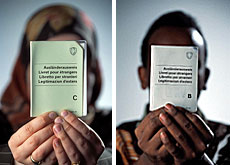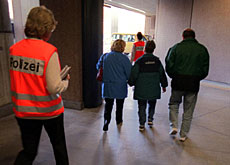Switzerland sees marked decline in asylum seekers

The number of asylum seekers arriving in Switzerland during the first half of the year has fallen by 17.2 per cent.
The Federal Refugee Office attributes the drop to measures taken in recent years and a general decline in asylum requests across Europe.
Figures out on Wednesday come just a day after the United Nations refugee agency told Switzerland that it was “seriously concerned” about plans to tighten the country’s asylum policy.
The Geneva-based UNHCR said some of the proposed measures ran contrary to the spirit and letter of the 1951 Refugee Convention.
And it pointed out that the proposals were being made at a time when the number of asylum seekers across Europe had dropped substantially.
The total number of people seeking refuge in Switzerland stood at 62,505 at the end of June – 5.6 per cent less than a year ago and the lowest level since the end of 1990.
Stabilise
According to Dominique Boillat, a spokesman for the Federal Refugee Office, the number of people seeking asylum in Switzerland is expected to stabilise.
“At the end of the 1990s, with the war in Kosovo, we had up to 110,000 asylum seekers and people who were admitted temporarily, which was a historical high,” he told swissinfo.
“Many of these people have now gone home and since 2000, their numbers have been falling slowly every year,” he added.
In the first six months of this year, the number of people leaving the country exceeded new asylum requests. A total of 8,391 persons asked for asylum, while 9,412 left the country.
Boillat echoed the UN refugee agency, saying that requests for asylum had been falling across western Europe since 2002.
He explained that the increase in people leaving was due to “better organisation”, adding that repatriation agreements with other countries were bearing fruit.
Restrictive measures
The government says restrictive measures across Europe are also having a long-term effect on the number of departures.
“Germany and the Netherlands have just tightened their asylum legislation and France is set to do the same,” said Boillat.
“Since last year the Dublin accord [on asylum] has been in force. A person can put in an asylum request in one country only and a centralised file can tell immediately if he has already been refused somewhere else.”
“It is important for Switzerland to join this system, if it does not want to inherit all those asylum seekers who were refused elsewhere,” he added.
Parliament is due to discuss joining the Dublin accord, which forms part of a second set of bilateral treaties with the European Union.
Going underground
However, Boillat said that although the number of asylum seekers leaving Switzerland had increased, the figures did not include those who had gone underground and had therefore disappeared from statistics.
Boillat also explained why Switzerland was not seeing a wave of asylum seekers from the Darfur region of Sudan or from Iraq.
“More often than not, there is no link between conflicts which break out and the number of requests for asylum in Switzerland. The people of Darfur can only manage to flee to the next border. They don’t have the means to arrive here,” he said.
The Federal Refugee Office said figures for June showed that 1,195 people had applied for asylum. This was 8.6 per cent more than in May, but 23.5 per cent less than in June last year.
Citizens from Serbia and Montenegro topped the list of asylum seekers in June with 172 requests, up by 8.2 per cent on the previous month.
As in April and May, Turks (112) and Georgians (53) followed in second and third place.
The Federal Refugee Office noted a marked increase of people arriving at the Swiss border from Slovakia and Bulgaria.
In the space of a month, the number of requests from Slovakians increased tenfold (52), while those from Bulgaria almost doubled to 49.
swissinfo with agencies
About 10% of asylum seekers are granted refugee status in Switzerland.
The number of asylum requests per 100,000 inhabitants:
Austria 875
Switzerland 643
Britain 277
France 189
Germany 147
The number of asylum seekers has fallen to its lowest level since the end of 1990. The total at the end of June was 62,505 or 5.6 per cent lower than 12 months ago.
The decrease in requests appears to be part of a general trend in Europe. In Switzerland, there has also been an increase of departures.
The Swiss justice ministry plans a further tightening of the admission policy, despite criticism and the falling numbers.

In compliance with the JTI standards
More: SWI swissinfo.ch certified by the Journalism Trust Initiative












You can find an overview of ongoing debates with our journalists here . Please join us!
If you want to start a conversation about a topic raised in this article or want to report factual errors, email us at english@swissinfo.ch.